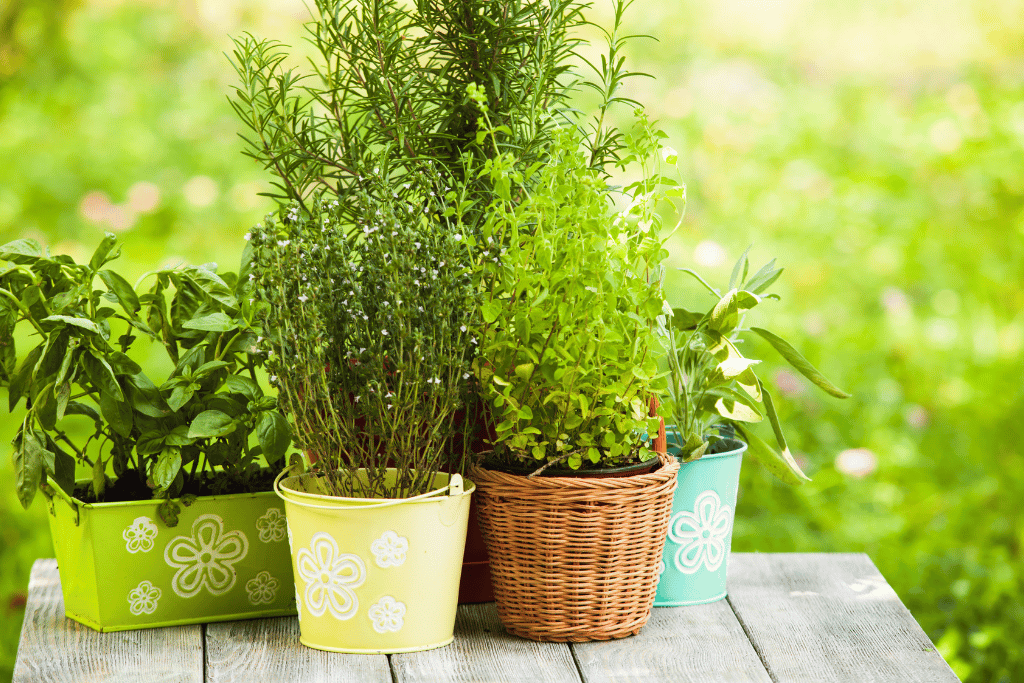You walk into your office and you realize it’s dull, it’s lifeless – the white walls staring at you. You want to make a change. Easy, you think, plants! But your office has no windows. What plants are perfect for offices without windows? There are actually many varieties to choose, let’s find out which…
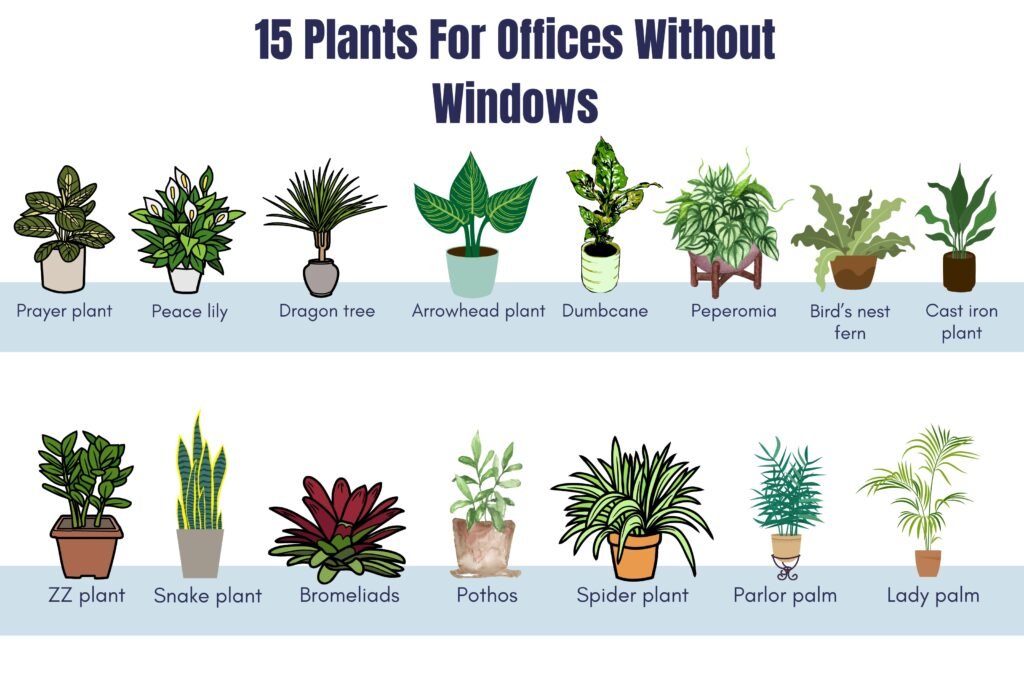
Indoor plants can improve air quality, reduce stress levels and make any workplace more inviting. In fact, the presence of plants helps people relax and create a positive environment.
The plants that thrive in offices without windows are mostly low-light plants. These plants don’t need direct sunlight and prefer indirect light. They can easily flourish with just a few hours of light every day.
So, let’s dig in and learn what plants are good for offices without windows.
What are the Benefits of Keeping Plants in Your Office?

Bringing nature indoors to an office that lacks windows can help provide countless physical and psychological benefits.
Improved air quality
The presence of plants inside a workplace is known to improve air quality and reduce the levels of airborne dust particles, volatile organic compounds (VOCs), bacteria, and fungi.
By introducing foliage into an office, there are numerous benefits to be had in terms of air quality, such as improved air temperature, increased humidity, and decreased airborne contaminants known to contribute to various respiratory issues.
Reduced stress levels
Having a few plants in an office can have a calming effect and help reduce stress levels among employees. Studies have shown that the presence of plants in an office setting stimulates workplace productivity and also helps to reduce stress levels by as much as 40%.
The presence of plants can also help regulate mood and create positive feelings, which has been demonstrated to lead to improvement in workplace morale.
Better focus and concentration
There is evidence that indoor plants can improve employees’ focus and concentration. A study found that workers with access to plants in their office were able to concentrate better and complete tasks faster than those without.
This is likely a result of improved air quality and the presence of calming green foliage.

Improved comfort levels
The presence of plants in an office can also help improve comfort levels among employees. This can also be due to the improved air quality, as plants absorb carbon dioxide and replace it with oxygen, helping to reduce the levels of airborne contaminants that can cause discomfort for workers.
The presence of foliage can help create a more pleasant and aesthetically pleasing environment which can help improve mood and thus comfort levels.
So, adding plants for offices without windows can help improve air quality, reduce stress and provide a pleasant environment
15 Plants For Offices Without Windows
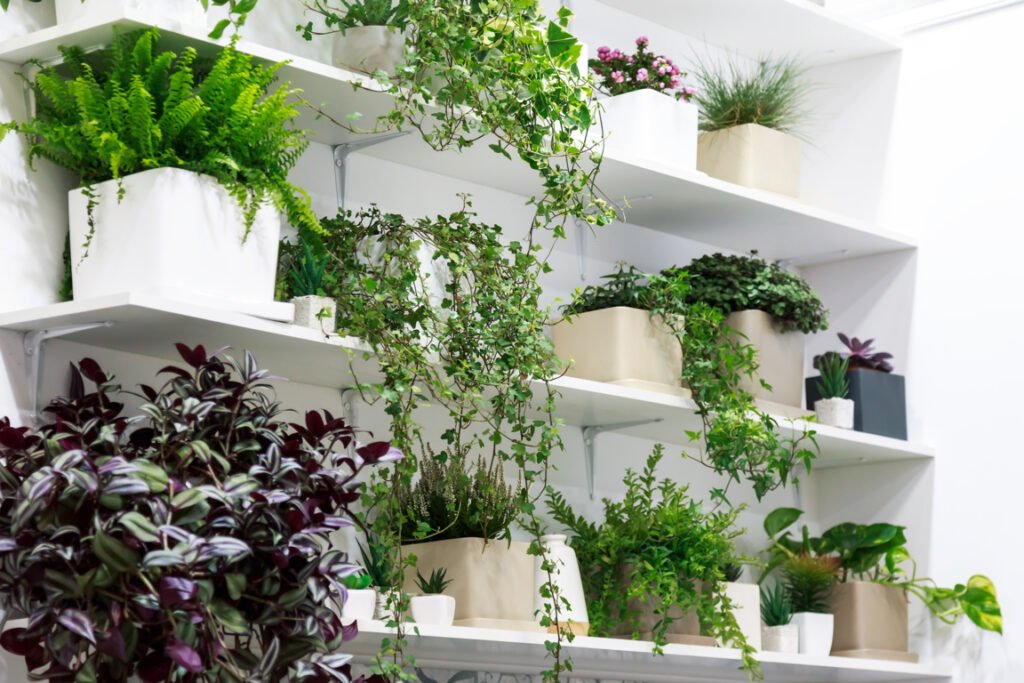
If you want to have a quick glance at what plants are best for offices without windows, consider the below table. It contains some of the varieties best suited for offices along with their sizes and requirements.
| Plant | Size | Ideal Water Requirements | Ideal Light Requirements |
| 1. Prayer plant | 10 – 12 inches tall | 1 – 2 weeks | Bright indirect light |
| 2. Peace lily | 3 feet | When topsoil is dry | Medium to bright indirect light |
| 3. Dragon tree | 6 feet | When topsoil is dry | Medium indirect light |
| 4. Arrowhead plant | 15 – 30 inches | When 50% of the topsoil is dry | Bright indirect light |
| 5. Dumbcane | 3 feet | 1 – 2 weeks | Bright filtered light |
| 6. Peperomia | 8 – 12 inches | 1 – 2 weeks | Medium to bright light |
| 7. Bird’s nest fern | 2 – 3 feet | 1 – 2 weeks | Medium to bright indirect light |
| 8. Cast iron plant | 2 – 3 feet | When topsoil is dry | Medium to low indirect light |
| 9. ZZ plant | 2 – 3 feet | 2 – 3 weeks | Lots of indirect light |
| 10. Snake plant | 3 feet | Fortnightly | Bright indirect light |
| 11. Bromeliads | Few inches to 3 feet | 1 – 2 weeks | Bright indirect light |
| 12. Pothos | 6 – 10 feet | 1 – 2 weeks | Bright indirect light |
| 13. Spider plant | 12 – 15 inches | Once a week | Bright indirect light |
| 14. Parlor palm | 4 feet | 1 – 2 weeks | Bright indirect light |
| 15. Lady palm | 7 feet | 1 – 2 weeks | Bright indirect light |
You can see there are lots of choices when discovering plants that will thrive without the sunlight provided by large windows. Let’s take a look at these plants in more detail:
1. Prayer plant
The Prayer plant, also known as the Maranta leuconeura, is a popular houseplant due to its unique foliage. It grows best in a warm and humid environment, making it an ideal choice for offices without windows.
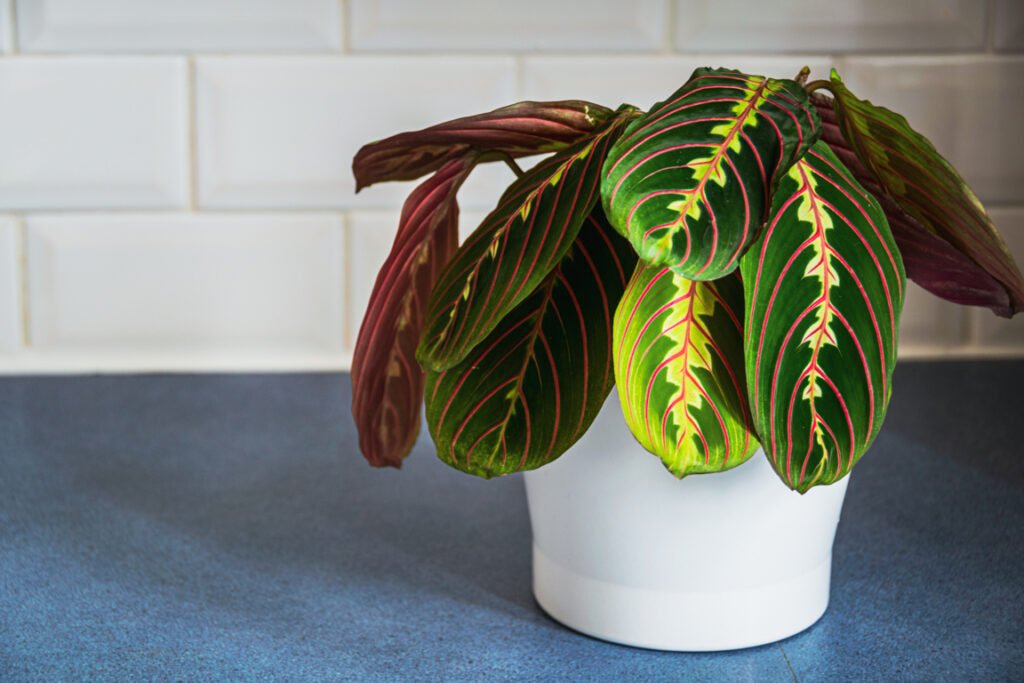
The plant is known for its distinctive foliage with leaves that appear to fold upwards in prayer at night and flatten during the day. It has bright green oval-shaped leaves covered in dark green stripes and may produce small white or purple flowers during the late spring season.
Size: It typically grows to be 10-12 inches tall with a spread of 15-18 inches.
Light requirements: The Prayer plant prefers indirect or partial sunlight when it comes to light requirements. It is important not to expose it to too much direct sunlight as this can cause its leaves to burn and fade in color.
Water requirements: The Prayer plant should be watered every 1-2 weeks, as this will help keep its soil moist and encourage healthy growth. When watering the plant, ensure to water from the bottom and avoid getting the leaves wet, as this can cause them to rot.
Caring: To ensure the best growth, it is important to keep the soil moist but not saturated. It should also be fertilized every two weeks during the growing season and misted regularly to help maintain humidity levels.
Tip: It is important to protect a Prayer plant from drafts, and sudden temperature changes as this can cause damage to the plant. Additionally, it is important to rotate the plant once a week so that it receives adequate light on all parts.
2. Peace lily
The Peace lily is a popular plant for offices without windows because of its low light requirements and easy care routine. It has dark, glossy leaves with white flowers that bloom year-round in the right conditions.
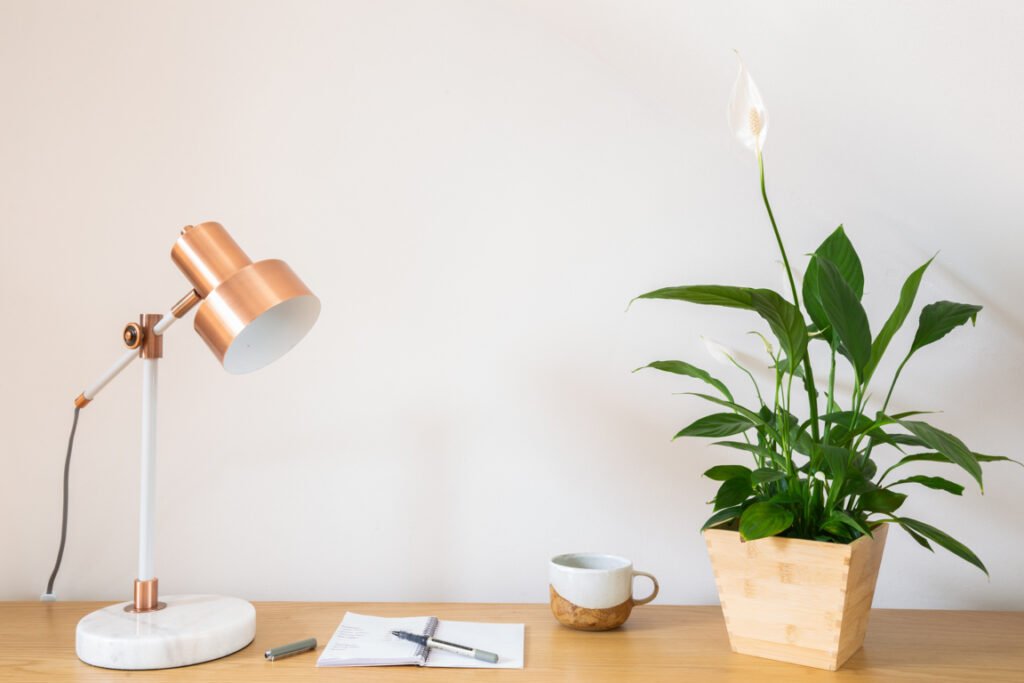
These can be termed as the best plants for offices without windows, as they help bring some life and color to your office space. With low maintenance care requirements, you can easily enjoy the beauty of nature indoors!
Size: Peace lilies can grow up to 3ft tall.
Light requirements: This plant prefers medium to bright indirect light and can tolerate low-light situations but will not flower.
Water requirements: It likes moist soil but does not like to be overwatered and can tolerate periods of drought.
Caring: To care for the Peace lily, water when the top inch of soil is dry, keep out of direct sunlight, and mist occasionally to increase humidity.
Tip: Peace lilies can also help to purify the air in enclosed spaces.
3. Dragon tree
Dragon trees are an excellent choice for offices without windows. This plant is known for its long, thin leaves and ornamental branches that give it a mysterious look. They can enhance the look of your office with their unique shape and require minimal care.
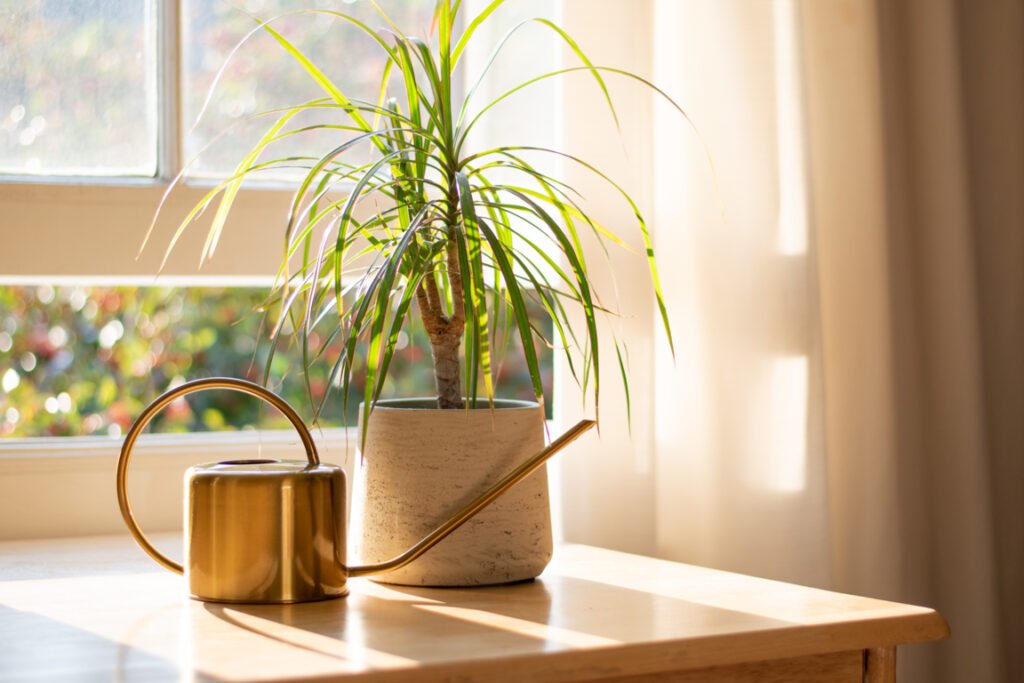
You can place them in a corner or on your desk. They are low-maintenance and can thrive in low-light conditions. Mist them regularly with lukewarm water to keep their leaves looking fresh and healthy.
Size: The dragon tree can reach heights of up to 6 feet.
Light: It requires medium, indirect light to thrive.
Water: Allow the soil to dry out between waterings. You will need to water it once a week.
Caring: Surprisingly, they do well when underwatered. Moreover, keep the humidity levels high in your office for optimal growth.
Tip: Dragon trees don’t require trimming or repotting, but you should wipe off their leaves so that dust doesn’t accumulate.
4. Arrowhead plant
Plants good for offices without windows should be easy to care for, long-lasting, and thrive in low-light conditions. The Arrowhead plant fits these criteria perfectly. Its unique foliage gives it a distinct arrow shape, making it an excellent showpiece for any office space.
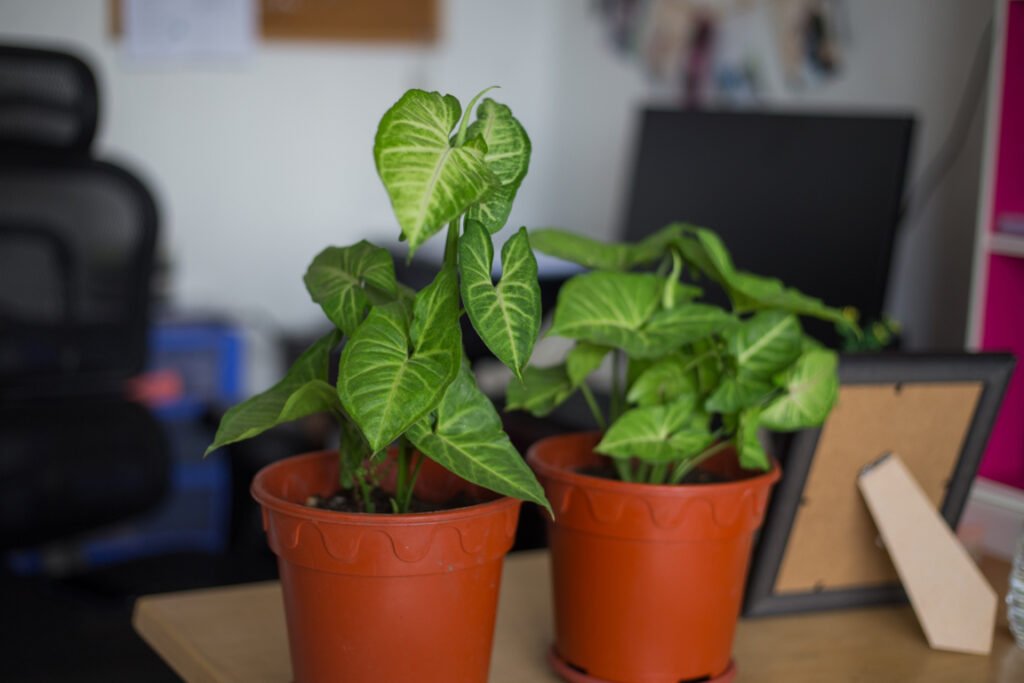
Size: The Arrowhead plant can grow between 15 and 30 inches tall in its natural environment.
Light: This plant is quite tolerant of low light levels and will thrive in any office without windows. It does appreciate a bit of bright indirect sun, but too much can damage the leaves.
Water: The Arrowhead plant prefers to be watered when the top inch of soil has dried out. Allow any excess water to drain away, and don’t leave it sitting in waterlogged soil.
Caring: To keep your plant healthy and looking its best, mist it with warm water once or twice a week. This will help keep the leaves clean and free of dust.
Tip: Prune frequently to ensure a bushy growth.
5. Dumbcane
Dumbcane is one of the best plants for offices without windows because it is low maintenance. It has broad, oval-shaped leaves that are variegated with green, yellow, or white stripes and spots. This plant requires very little light to survive, making it perfect for offices without windows.
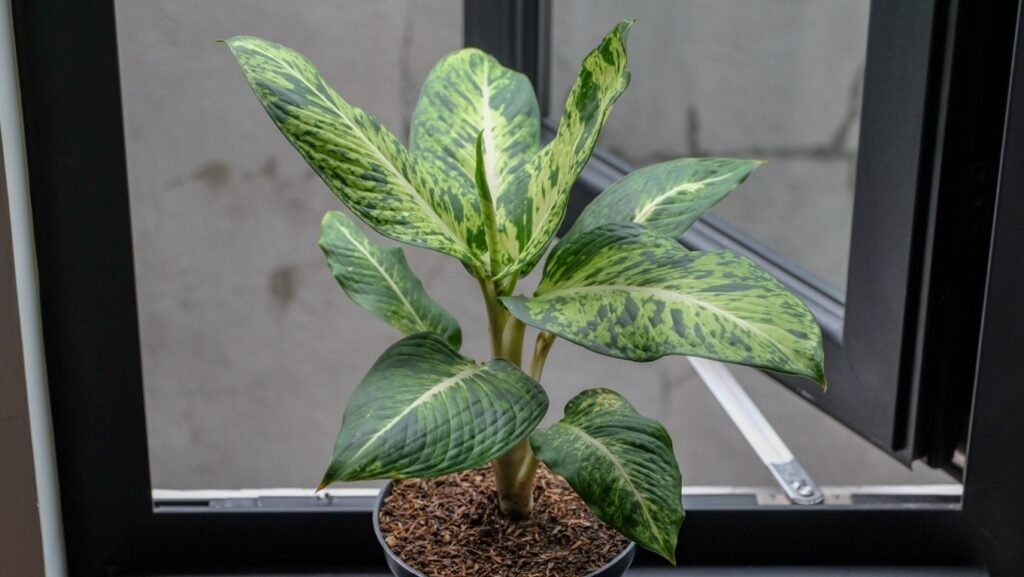
Size: It is a slow-growing plant and can reach up to 3 feet in height.
Light Requirements: This plant requires bright filtered light to thrive well.
Water Requirement: It needs to be watered every 1-2 weeks, as it is prone to root rot if kept constantly wet. Allow the soil to dry out before you water it again.
Caring: Dumbcane is a relatively easy plant to care for. It should be fertilized every month or two during the growing season in the spring and summer months. Make sure to prune any dead leaves or stems as soon as they appear.
Tip: Keep this plant away from direct sunlight, as it can cause the leaves to burn.
6. Peperomia
Peperomia is a delightful and easy-going plant that ishas been popular when it comes to plants for offices without windows. This attractive little succulent has thick stems, lush foliage, and small flowers. Its pointed leaves can be green or purple, depending on the variety you choose.
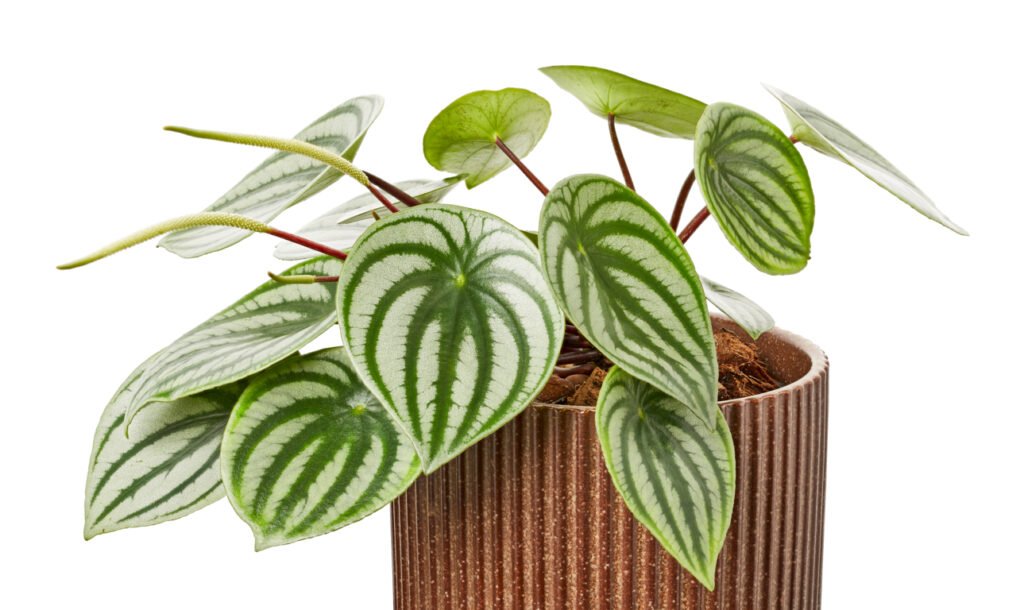
Size: Peperomia plants are generally on the smaller side, and most varieties reach heights between 8-12 inches.
Light Requirements: Peperomia plants do best in medium to bright indirect light. Avoid direct sunlight, which can cause the leaves to scorch.
Water Requirements: Peperomias don’t need a lot of water and are susceptible to root rot if overwatered. Allow the soil to dry out between waterings, and then water thoroughly. Water them every 1-2 weeks.
Caring: Peperomias can be prone to pests, so it’s best to inspect your plants regularly for any signs of damage or infestation. Prune away any damaged or dead leaves to keep the plant looking its best.
Tip: Place them in vibrant spots with indirect light. You can also place them near fluorescent lighting for healthy growth.
7. Bird’s nest fern
Native to tropical regions of Asia and Australia, the Bird’s nest fern is an excellent choiceas it requires minimal attention. This fern is known for its lush, deep-green fronds that grow in a nest-like shape.
They will uplift any office without windows and don’t require much bright light.
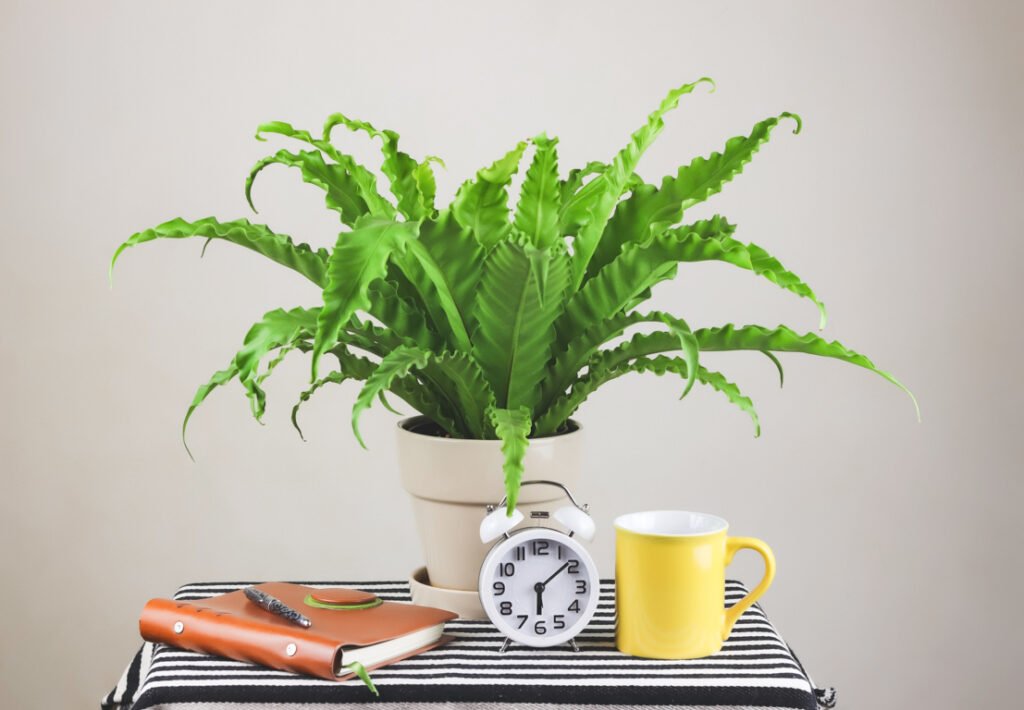
Size: The Bird’s Nest Fern typically grows about 2 to 3 feet in height and width.
Light Requirements: The Bird’s nest fern prefers medium to bright indirect light. It can tolerate low-light conditions as well.
Water Requirements: Water the plant when the soil is dry to the touch, and use lukewarm water. Also, do not overwater, as this can kill the plant. Water them every 1-2 weeks.
Caring: To keep your Bird’s nest fern healthy, mist plants once a week with lukewarm water and fertilize it twice a year with a general-purpose fertilizer.
Tip: Place the plant in an area of your office that is not too close to a radiator or air conditioning vent, as plants don’t like sudden changes in temperature.
8. Cast iron plant
An excellent choice for an office without windows is the Cast iron plant. This robust plant is known for its ability to withstand difficult conditions and is a great way to bring some of nature indoors. Also known as Aspidistra elatior, it is an evergreen perennial plant from the lily family.
It’s known for its unique shiny, dark green leaves that can give a chic look to your office.
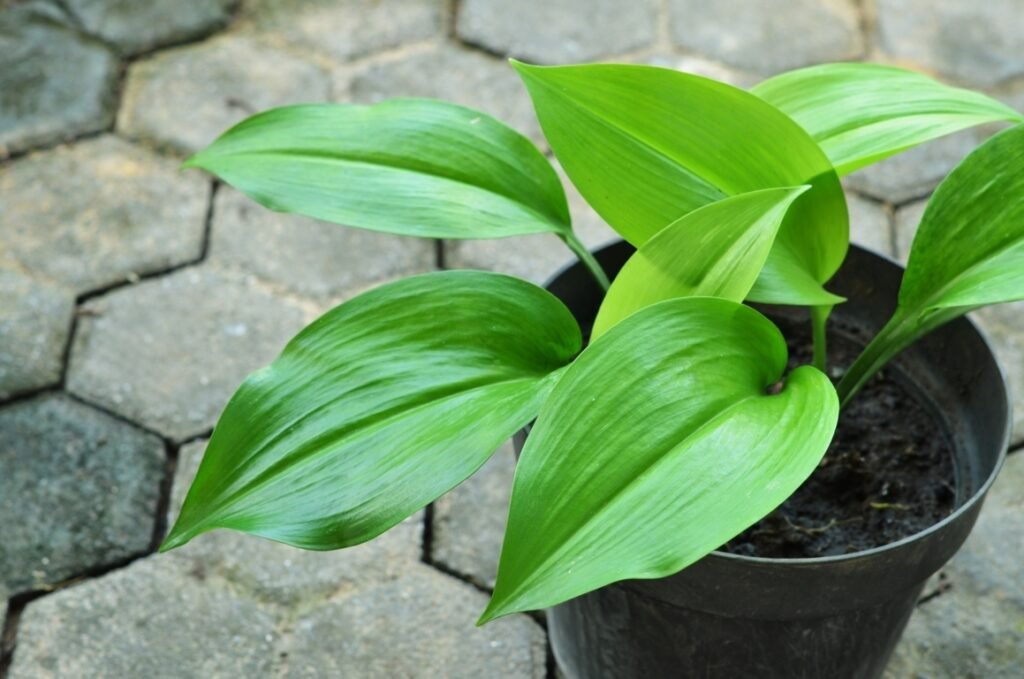
Size: Cast Iron plants reach a height of up to 2–3 ft (60–90 cm).
Light: This plant prefers medium-low indirect light. It can tolerate bright indirect light too, but it’s not recommended.
Water: Cast iron plants should be watered when the topsoil feels dry.
Caring: To keep them in good condition, keeping them away from drafts and areas with extreme temperatures is best. Place your plants in a spot where they won’t be exposed to too much direct sunlight.
Tip: Try rotating your plants weekly to promote even growth.
9. ZZ plant
The ZZ plant, or Zamioculcas zamiifolia, is a low-maintenance and versatile houseplant ideal for offices without windows. It is best known for its glossy, deep green foliage and thick rhizomes that help it survive in harsh conditions.
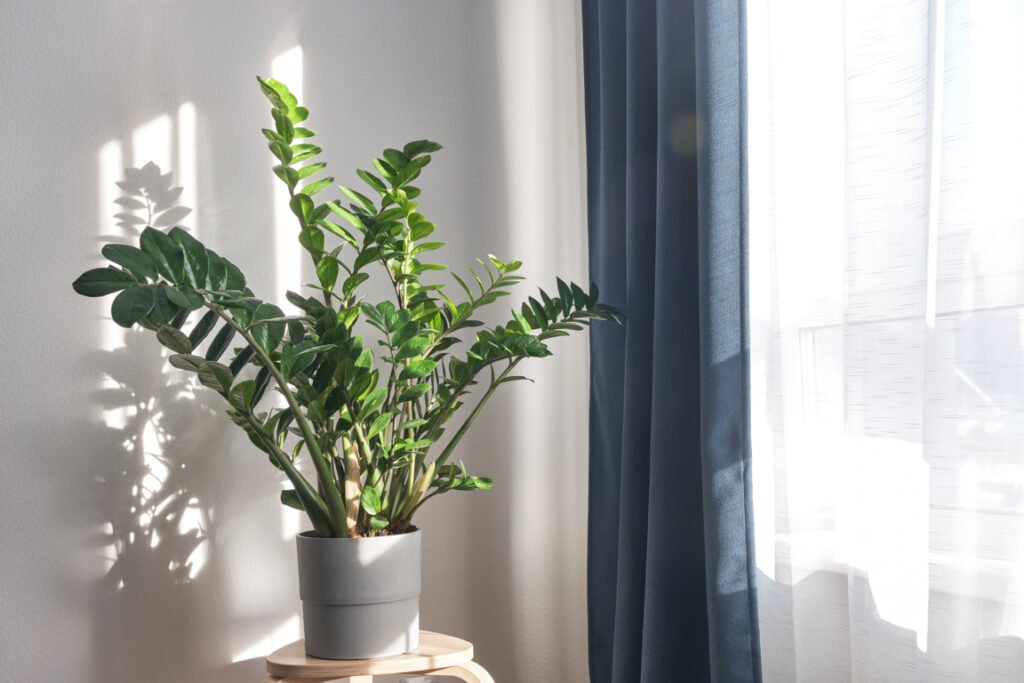
Size: The ZZ plant typically grows to a height of 2-3 feet and can spread up to 3 feet in width.
Light requirements: When it comes to light, the ZZ plant prefers indirect or filtered sunlight but can survive in almost any lighting condition. It is essential to avoid direct sunlight as this can cause the leaves of the plant to burn and fade in color.
Water requirements: The ZZ plant does best when watered only every few weeks (two-three weeks), as this allows its soil to dry out completely between waterings. When watering the plant, ensure not to saturate the potting mix and avoid getting the leaves wet, as this can cause them to rot.
Caring: It is best cared for by regularly removing any dead or dying leaves. The plant must also be fertilized with a balanced fertilizer every six months during the growing season and watered infrequently during the winter.
Tip: Keeping the plant slightly on the dry side is best, as overwatering can cause root rot and other issues.
10. Snake plant
The Snake plant looks excellent in offices without windows. Its appearance compliments best in any office setting, and its low light requirements make it easy to care for and maintain. The sharp pointy leaves add a unique and modern look to your office.
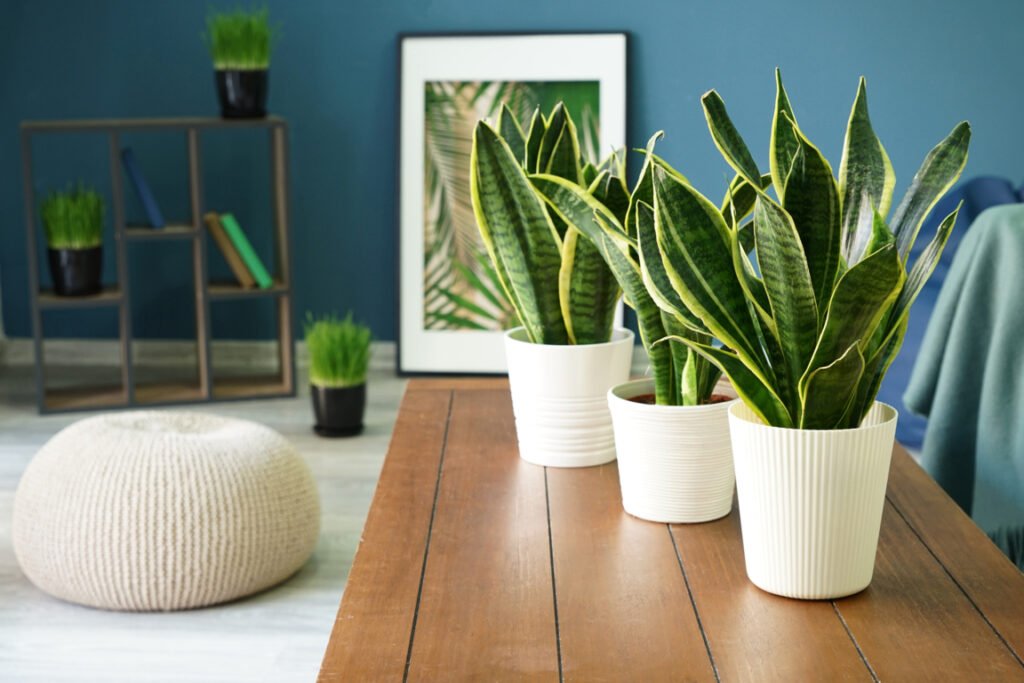
Size: The Snake plant grows up to 3ft tall with a spread of 2ft wide.
Light requirements: The Snake plant can thrive in almost all light conditions ranging from low to high – indirect light. It is best to avoid direct sunlight as this can cause the leaves to burn.
Water requirements: It is a very low-maintenance plant and only needs to be watered fortnightly or when the soil feels dry. Over-watering should be avoided, as this can cause root rot.
Caring: To best care for a Snake plant, it is best to let the soil dry out completely before watering again. The foliage should also be dusted and misted regularly to keep its vibrant color and appearance.
Tip: Snake plants are known for their air-purifying abilities, making them an excellent addition to any office without windows. Moreover, they can also boost mental health and productivity in the workspace, making them a great plant to have around.
11. Bromeliads
If you’re wondering what plants are good for offices without windows that also require minimal maintenance, the Bromeliads is your best bet. They are hardy, colorful plants that make a beautiful addition to any office without windows.
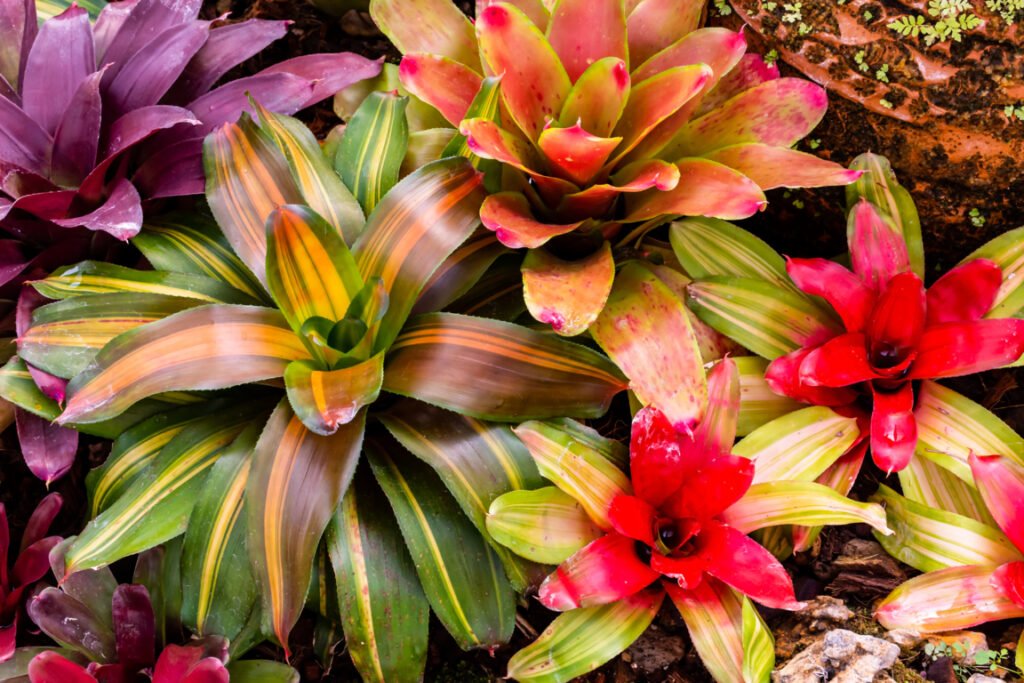
With their striking foliage and easy care needs, they are one of the best plants for offices without windows. These plants come in many different sizes and colors, making them perfect for any space.
Size: The size of a Bromeliad can vary depending on its type, but they range from a few inches to several feet in height, mostly up to 3 feet.
Light: Since these plants don’t need direct sunlight, they are perfect for offices without windows. They do best in bright indirect light and will tolerate lower light levels.
Water: Watering Bromeliads can be tricky, as they need to dry out between waterings. Too much or too little water can cause them to rot. The best way to water them is to drench the soil and let it drain away any excess moisture.
Caring: They are low-maintenance plants that require minimal care. Fertilize bromeliads every few months with a liquid fertilizer diluted at half-strength.
Tip: To help your bromeliad thrive, mist around the foliage once or twice a week in addition to regular watering.
12. Pothos
Pothos is a strong contender when it comes to plants that are good for offices without windows. This vining plant has tolerance to lower light conditions. Its beautiful heart-shaped leaves come in a variety of colors and sizes, making them perfect for any office space.
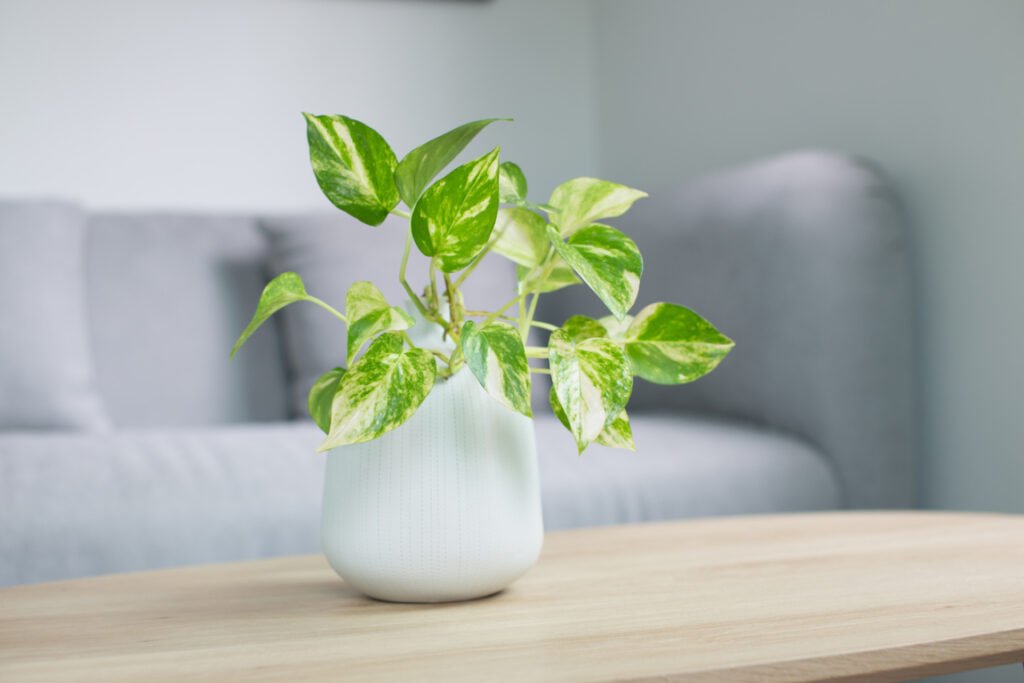
Size: The size of a Pothos plant can vary depending on how often it’s trimmed, but it typically grows between 6 – 10 feet long when grown in containers.
Light requirements: Pothos thrive best in bright indirect light and can survive in lower light levels. They do best with medium or bright light, but no direct sun.
Water requirements: They are quite drought tolerant and need less frequent watering than other plants. Water them when the top two inches of soil are dry. Do not over-water, as they are prone to root rot.
Caring: Trim pothos plants every few months to keep them manageable and help them grow faster. You can also propagate new plants from stem cuttings or by division.
Tip: If your plant starts to look wilted and droopy, it may need more water than usual.
13. Spider plant
Spider plants are one of the best houseplants for offices without windows. These plants are easy to care for, and their long, slender foliage adds a touch of style to any office.
You can place them in hanging baskets or let them grow on shelves and desks.
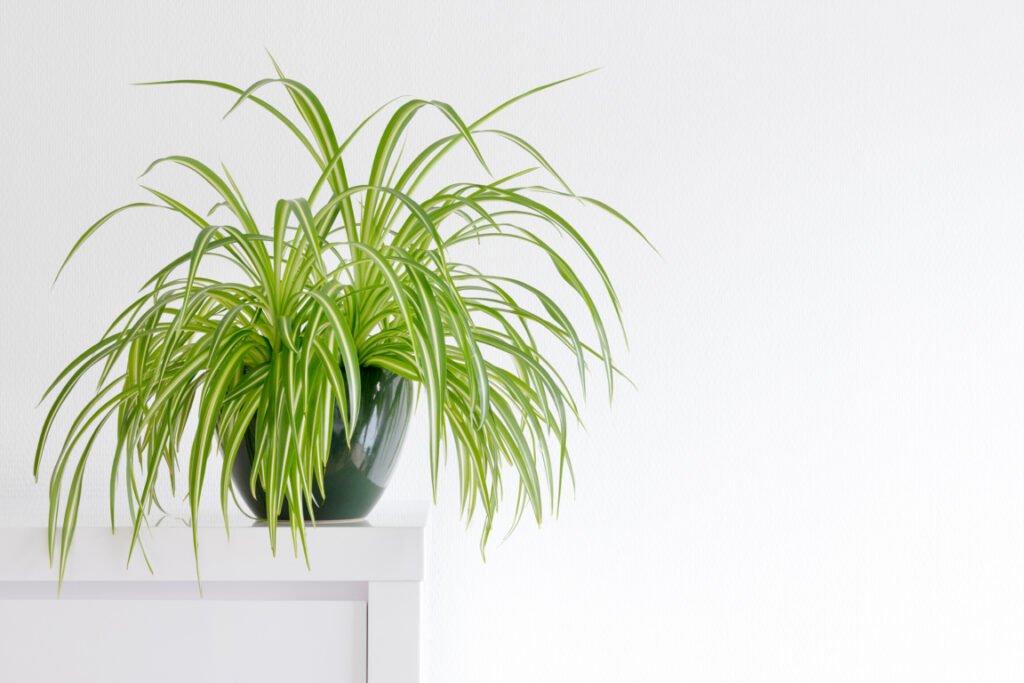
Size: Spider plants range in size from 12-15 inches tall, depending on their environment and how often they’re trimmed.
Light: They prefer bright indirect light but can also tolerate lower light levels. They do best with medium to high light, but avoid direct sun.
Water: Water your spider plant once a week. But good practice is to examine the soil first. You can wait for a day or two more if it feels dry.
Caring: Trim your spider plant every few months to keep it from getting too large and leggy. You can also propagate new plants from stem cuttings or by division.
Tip: Spider plants do best in well-draining soil and should be fertilized every few months with a liquid fertilizer diluted at half strength.
14. Parlor palm
Parlor palms have long, graceful fronds and make a beautiful addition to any office. Also known as Neanthe bella, this plant is popular for its hardy nature and tolerance to low light. Its deep green foliage adds a touch of elegance to any room, even in your office.
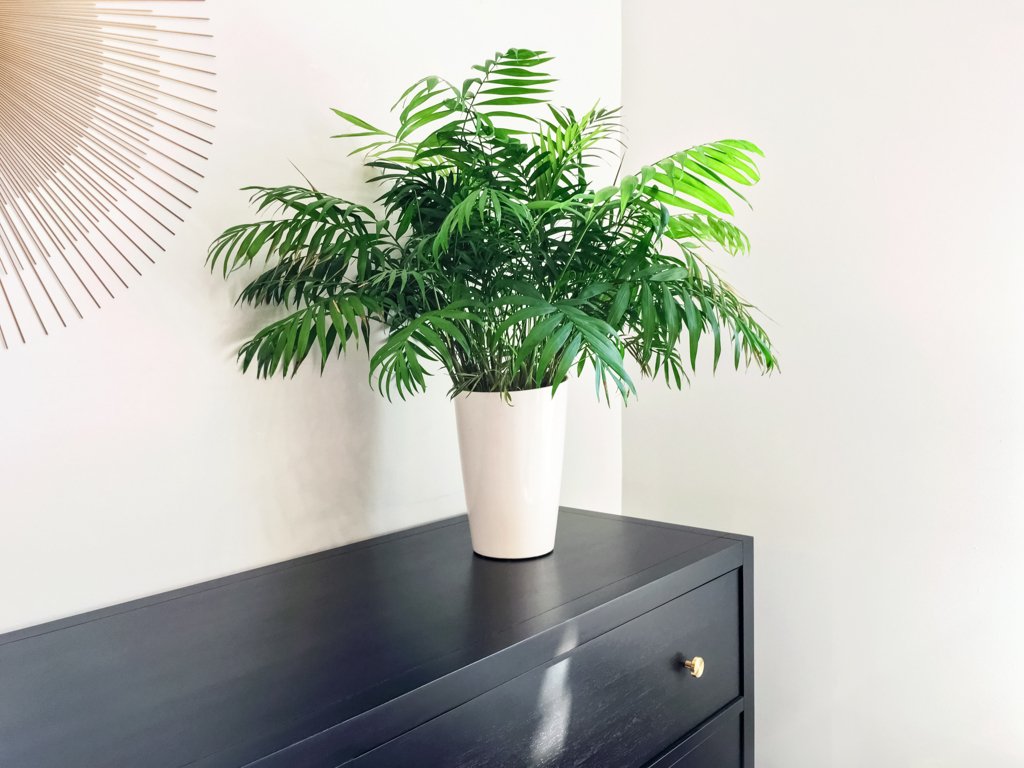
Size: Parlor palms typically grow up to four feet tall, but can reach up to eight feet in the right conditions.
Light: They prefer bright indirect light, but can tolerate lower light levels as well. They do best with medium or high light, but avoid direct sun.
Water: Parlor palms need to be watered once a week, with the soil drying out in between waterings. Too much water can cause root rot and other diseases.
Caring: They require minimal care but should be fertilized every few months with a balanced houseplant fertilizer. The leaves should also be regularly wiped down with a damp cloth to remove dust and dirt buildup, which can diminish its light absorption.
15. Lady palm
If you can’t decide on what plant for your office without windows, consider Lady palm. This indoor plant is known for its air-purifying properties and can bring a sense of tranquility to any workspace. Its wide, lush leaves create an elegant look that’s perfect for home offices or professional workspaces.

Size: They typically grow up to seven feet tall, but can reach up to nine feet in the right conditions.
Light requirements: Lady palms prefer bright indirect light, but can tolerate lower light levels as well. They do best with medium or high light, but should not be in direct sun.
Water requirements: They prefer moist soil and need to be watered every one to two weeks. Do not overwater, as this plant is prone to root rot.
Caring: Lady palms require minimal care and should be fertilized every few months with a balanced houseplant fertilizer. Its large leaves should also be regularly wiped down with a damp cloth to remove dust and dirt buildup.
Tip: These plants are sensitive to fluoride, so it’s best to only use distilled or rainwater on them. This will help them stay healthy and free of disease.
How to Choose Plants that are Good for Offices Without Windows
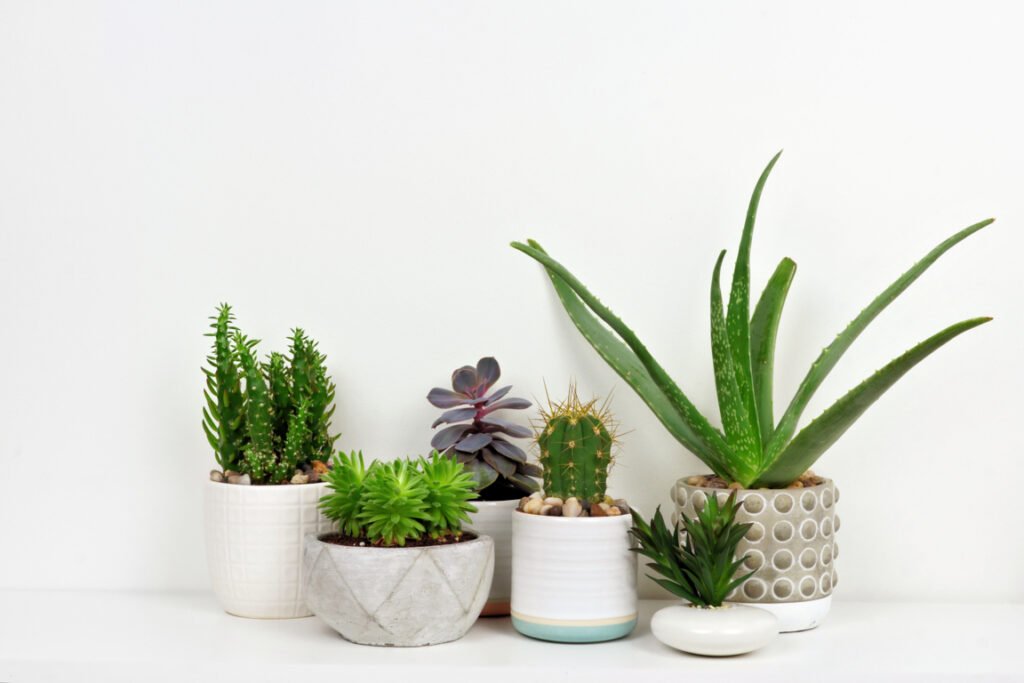
You need to look into certain factors when selecting the best plants for offices without windows. These factors are:
1. Amount of light available
The amount of natural light available in your office will play an essential role in choosing the type of plants. If your office does not have any windows, then you will want to select plants that can thrive in low-light conditions such as peace lilies or pothos plants.
2. Avoid thirsty plants
Watering plants is a necessary part of keeping them alive, but if your office has no windows or access to a water source, you should avoid plants that need frequent watering. The best choices are snake plants because they must be watered fortnightly and can tolerate dry conditions for a few weeks.
3. Choose air purifying plants
Air purifying plants are a good choice for offices without windows because they help to reduce pollutants and increase oxygen levels in the air. These types of plants include spider plants, peace lilies, and ZZ plants, as they thrive in low-light conditions and require minimal water.
4. Consider plant size
The size of the plant is also an essential factor to consider when selecting plants for offices without windows. If you are limited on space, then opting for bird’s nest fern or peperomia plants may be a better choice because they are smaller in size and can fit into cramped spaces.
5. Opt for low maintenance varieties
Another important factor to consider when choosing plants for offices without windows is the amount of maintenance each plant requires. Cast iron and snake plants are excellent choices as they require minimal maintenance and can survive in lower light conditions.
How do I Enhance the Overall Look of my Office Using Multiple Plants?
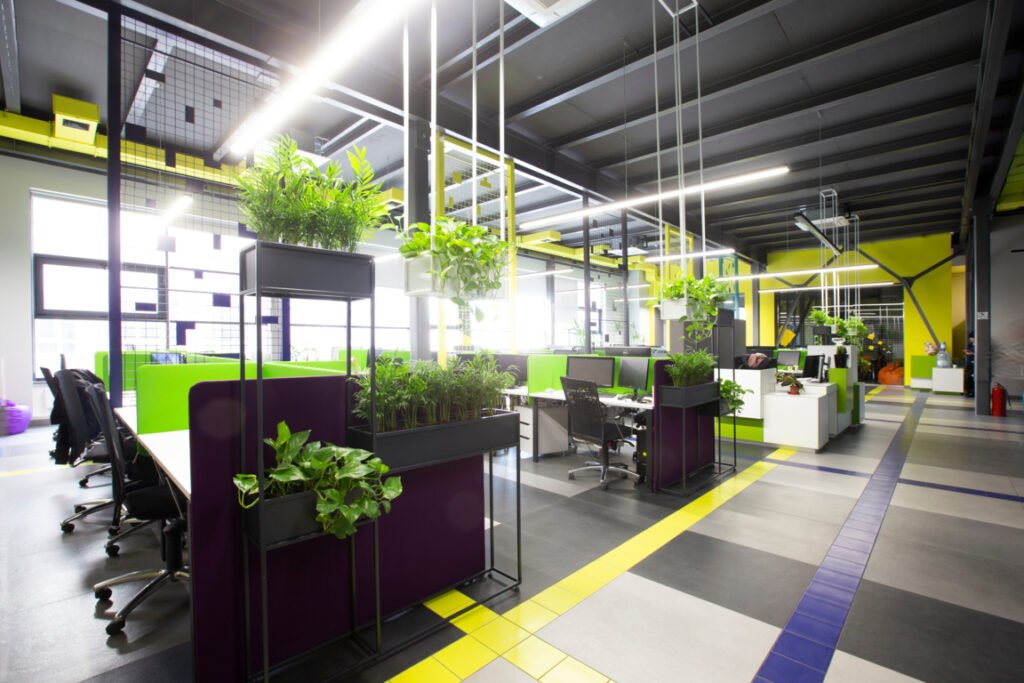
When it comes to adding plants to an office without windows, you have a variety of options. You can create a serene atmosphere by arranging several smaller office plants throughout the space, or make a bold statement with larger, more decorative greenery.
Group multiple plants:
Grouping multiple plants together helps create an attractive display that is visually pleasing to the eye and can help cover up any unsightly clutter. Place them in clusters on tables, shelves, or desks to create the illusion of a garden indoors.
If your office doesn’t have enough natural light for live plants, consider using artificial ones instead. They are just as attractive and come in a wide variety of sizes and shapes.
Hanging plants for higher ceilings:
For an uplifting touch, add colorful plants to bring a cheerful look to the space and can help brighten up dull walls or corners. Consider hanging plants from the ceiling for an eye-catching display for offices with higher ceilings.
Choose easy-to-care plants:
Lastly, make sure you choose easy-care plants that require little maintenance and won’t need to be watered or pruned often. You can also buy self-watering pots to help keep your plants hydrated if you don’t have time for regular watering.
Overall, bringing some greenery into a windowless office is an easy way to create an inviting atmosphere that boosts productivity and creativity. You can easily transform your office into a bright and vibrant work environment with a few simple tricks.
Ready to bring the beauty and calm of nature to your office?
For offices without natural light, there is no need for despair – with our guide to the best plants for offices without windows, you can easily bring some of nature indoors. From hardy and undemanding plants to lush ferns and easy-care palms, many plants will thrive in artificial light.
Look for plants best suited to the level of light available in your office, and make sure to water regularly. In no time, you will have an office with a healthy indoor environment and all the benefits that plants bring.
Go ahead and get some plants for your office – your colleagues, physical health, and mental well-being will thank you for it!



